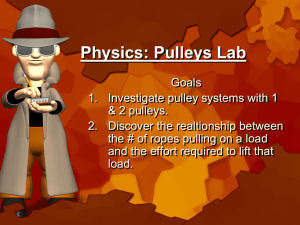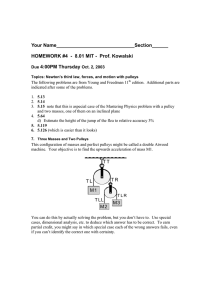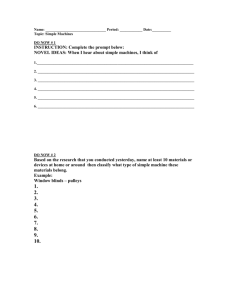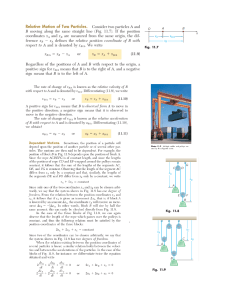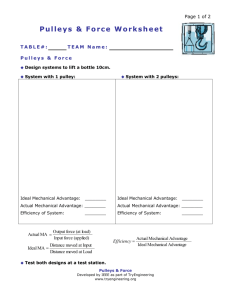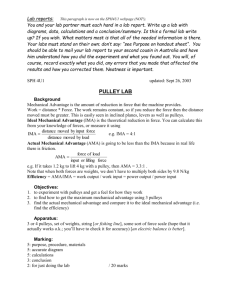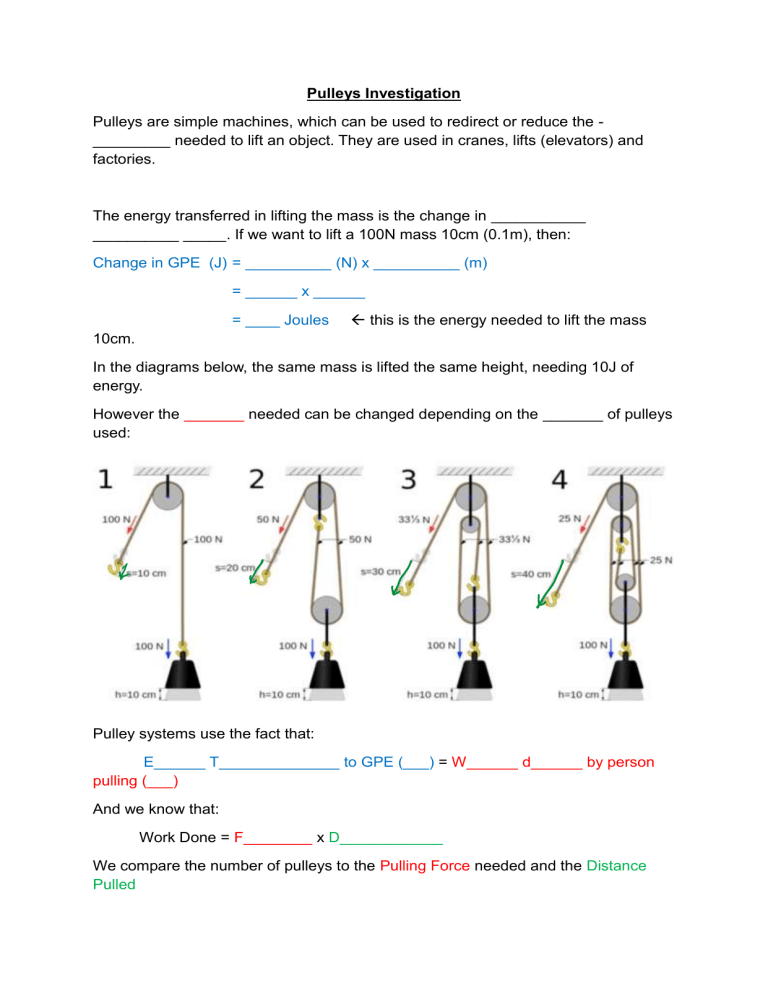
Pulleys Investigation Pulleys are simple machines, which can be used to redirect or reduce the _________ needed to lift an object. They are used in cranes, lifts (elevators) and factories. The energy transferred in lifting the mass is the change in ___________ __________ _____. If we want to lift a 100N mass 10cm (0.1m), then: Change in GPE (J) = __________ (N) x __________ (m) = ______ x ______ = ____ Joules this is the energy needed to lift the mass 10cm. In the diagrams below, the same mass is lifted the same height, needing 10J of energy. However the _______ needed can be changed depending on the _______ of pulleys used: Pulley systems use the fact that: E______ T______________ to GPE (___) = W______ d______ by person pulling (___) And we know that: Work Done = F________ x D____________ We compare the number of pulleys to the Pulling Force needed and the Distance Pulled Number of pulleys Pulling Force (N) Distance Pulled (m) Work done (J) Energy transferred (J) Graph of Results: 1 2 3 4 How force changes when more pulleys are used 120 Pulling Force (N) 100 80 60 40 20 0 0 1 2 3 4 5 6 7 Number of pulleys Describe the relationship shown by the graph: As the number of pulleys increases, the pulling force _____________ However the W___ D____ is always the same (Force x distance always equals 10 Joules). This means that the person has to use the same e________ to lift the mass 10cm, but if they want to use a smaller f________, they have to pull the string a bigger d___________. Can you use the graph to work out how much force would be needed if there were: a) 5 pulleys? b) 7 pulleys? Show your working on the graph. Pulleys Investigation Pulleys are simple machines, which can be used to redirect or reduce the force needed to lift an object. They are used in cranes, lifts (elevators) and factories. The energy transferred in lifting the mass is the change in Gravitational Potential Energy. If we want to lift a 100N mass 10cm (0.1m), then: Change in GPE (J) = weight (N) x height (m) = 100 x 0.1 = 10 Joules this is the energy needed to lift the mass 10cm. In the diagrams below, the same mass is lifted the same height, needing 10J of energy. However the Force needed can be changed depending on the number of pulleys used: Pulley systems use the fact that: Energy Transferred to GPE (J) = Work done by person pulling (J) And we know that: Work Done = Force x Distance We compare the number of pulleys to the Pulling Force needed and the Distance Pulled Number of pulleys Pulling Force (N) Distance Pulled (m) Work done (J) 1 100 0.1 100 X 0.1 = 10 10 Energy transferred (J) Graph of Results: 2 50 0.2 50 X 0.2 = 10 10 3 33.3 0.3 33.3 X 0.3 = 10 10 4 25 0.4 25 X 0.4 = 10 10 How force changes when more pulleys are used 120 Pulling Force (N) 100 80 60 40 20 0 0 1 2 3 4 5 Number of pulleys Describe the relationship shown by the graph: As the number of pulleys increases, the pulling force decreases 6 7 However the Work Done is always the same (Force x distance always equals 10 Joules). This means that the person has to use the same energy to lift the mass 10cm, but if they want to use a smaller force, they have to pull the string a bigger distance. Can you use the graph to work out how much force would be needed if there were: a) 5 pulleys? b) 7 pulleys? Show your working on the graph.
